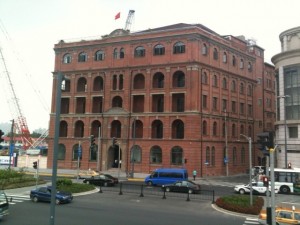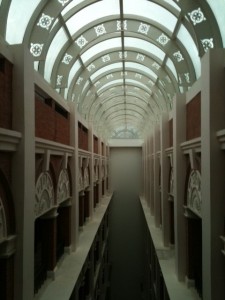Posted: August 30th, 2011 | No Comments »
In September (from Sept 5-Nov 28), Beijing Postcards will be putting on a special exhibition entitled ‘Beijing on the Move’, exploring how Beijing has gone from being an enclosed, gated city to the sprawling metropolis it is now.
Over 100 years ago, city life moved to and fro via the nine gates which monitored the comings and goings of people in Beijing. These were both hubs of activity and very literal symbols of Beijing’s boundaries and ambitions. Today, their names are familiar, but the gates themselves have ceased to hold any importance. In a series of pieces, photographs and images, Lars Ulrich of Beijing Postcards explores how their disappearance signalled the emergence of a modern Beijing.
‘Beijing on the Move’ is at 69 Yandai Xiejie (just South of the Drum Tower), Chaoyang district (6406 7469), Beijing. Open Sept 5-Nov 28, 10.30m-10.30pm.
 Fuchengmen – The Coal Gate
Fuchengmen – The Coal Gate
Posted: August 29th, 2011 | 2 Comments »
Midnight in Peking is available in English to pre-order on Amazon.cn – and at a discount price – the only snag? you have to be in the PRC to get it delivered!

Posted: August 29th, 2011 | No Comments »
I don’t know much about this building or the problems that apparently beset it of late but I’ll add it to the blog anyway with links. There appears to be a row about a Chinese TV celebrity by the name of Zhao Benshan who’s media company is the operator of an upscale club inside the “newly renovated” Liulaogen Guildhall building in Qianmen. Reporters who often highlight architectural damage claim that the siheyuan, or courtyard, has been damaged by additional structures. The Guildhall comprises 6 siheyuan in total apparently, protected and about 280 years old.
Anyway, there’s various stories about what has or hasn’t happened here that I’ll point you too as I am not familiar with this structure of this project to a degree enough to make any form comments:
China Daily and again here
Global Times

Posted: August 29th, 2011 | No Comments »
The website that goes with my new book Midnight in Peking (I’m in Melbourne at the moment selling it) is completely brilliant. I’d go so far as to say that no author and publisher has ever got together to build such a cool website for a book. All ChinaRhymers will love it, I can assure you – there’s loads or old Peking pics, links and information on the Tartar Wall, the Badlands and the Legation Quarter. There’s an audio walk through the Peking of 1937 and a rather excellent video filmed at those locations with me doing my Simon Schama impression!
The site has loads on it including downloadable images of old Peking and old maps too. There’s information for book clubs that might like the book as well as details of where I’ll be speaking over the next few months. And, of course, the fact that the mighty David Peace blurbed my book does not got unremarked upon!!
No problems finding the site – www.midnightinpeking.com – how easy is that!
And if you want a copy of the book and you’re in Australia click here, or in China then click here. If you’re in Europe or America then I’m afraid you’ll have to wait till next year!!

Posted: August 28th, 2011 | No Comments »
The old Butterfield and Swire building on the former Quai de France, or French Bund, (now Zhongshan Dong Er Lu) is all that remains with any history to it. Actually nothing much else is there now, as the developers clear land, except a few rather predictably crap pieces of early 90s Shanghai architecture about which the less said the better.

No.22 is effectively the last man standing on that part of the riverfront south of Avenue Edward VII (Yanan Road). The rest has been pulled down, bulldozed, harmonised into temporary parks that will soon make way for a grotesque SOHO development that will overshadow the former British Bund and generally cast gloom both architecturally and heritage wise. Such is what passes for progress in quick-obsessed, dodgy developer-controlled Shanghai.There used to be a plethora of old godowns, warehouses and commercial premises around here running along to the colonnaded and once truly splendid Rue du Consulat (Jinling Road). For a nice summary of the history and architecture of the French Bund do read this piece from Hugues Martin’s excellent Shanghailander blog.
At least it looks like it will stay, though visiting a restaurant in the building called Brix the other day you immediately note that now the view to the south is a typical insta-park with scaffold supported insta-trees but will soon just be the walls and windows of a massive SOHO high rise – it’s going to be permanently dark dining in Brix I fear!
Not sure what they’re calling this redevelopment – 22 South Bund on the outside and then Bund 1906 on the inside. Externally the building looks great actually if a little marooned! Internally it’s now a sort of messy sub-Venetian, cod-classical mash up that obviously doesn’t really work and is, rather unfortunately, faintly reminiscent of the main hall of an old Victorian prison like Brixton or Pentonville – Brixton Prison is the picture on the right below by the way for anyone confused, the luxury new development is on the left…or maybe it’s the other way round…I’m all confused now…


When will the anti-suicide nets be fitted at No.22 South Bund one wonders?
Posted: August 25th, 2011 | No Comments »
An interesting new book for those who have known Hong Kong’s infamous Chungking Mansions over the year: Gordon Mathews – Ghetto at the Center of the World: Chungking Mansions (shame Hong Kong University has decided to adopt American spelling). Anyway here are the details as per usual.

-Â Offers an ethnographic portrait of Chungking Mansions and the people within it from African traders to Pakistani and Indian proprietors to Chinese owners to asylum seekers, heroin addicts, sex workers, and tourists.
– Lays bare the building’s residents’ intricate connections to the international circulation of goods, money, and ideas.
- Shows how the building is an epitome of the way globalization actually works for most of the world’s people.
Posted: August 24th, 2011 | No Comments »
So last night the great and the good of Beijing gathered on the roof the Beijing Bookworm to do an official launch of my new book Midnight in Peking. A massive thanks to Penguin, the Bookworm and everyone who came – it was a great night of old Peking gossip and gabbing!
I’m heading to Australia for the literary festivals in Melbourne and Brisbane but we wanted to make sure that the home crowd in Beijing got first glimpses and first opportunity to buy…and some free drinks in the evening heat.
There’s some pictures here of the evening courtesy of The Beijinger…
And so the Midnight in Peking show is now most definitely on the road for the next year!!

Posted: August 24th, 2011 | 1 Comment »
Answer: they’re both a major threat to Shanghai’s heritage and historic architecture
Many thanks to the young people (and they really are very young actually) over at Shanghaiist who drew my attention to this story from the Shanghai Daily (what do you mean you don’t subscribe!!) about the threat termites are to Shanghai’s historic buildings. The article cites any number of historic buildings with termite problems but imagine the situation in those buildings where nobody’s going to call pest control. I can tell you from experience that sub-division of old buildings hasn’t helped – unless the entire structure and surrounding gardens are treated then invariably the treatment will be ineffectual. In Shanghai’s current phase of high levels of alienation, people being arsey for the sake of it and downright unfriendly there’s always one person in the building who refuses to have their rooms treated. Usually it’s because they don’t want to pay or just downright pig ignorant.
Termites are nothing new in Shanghai – Shanghailanders were complaining about them in the nineteenth century. Of course the government could step in and launch and fund an eradication campaign but as they’re not keen to pay for healthcare or pensions it’s unlikely they’ll be paying for termite eradication and architecture preservation.
Apparently it’s about RMB300 to eradicate a nest of termites – communists unfortunately are a bit harder to eradicate (but not, let us always remember, impossible!).










